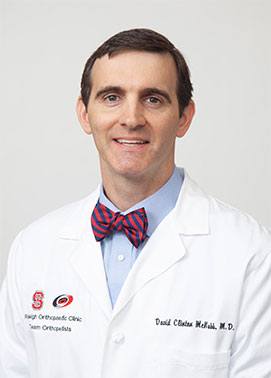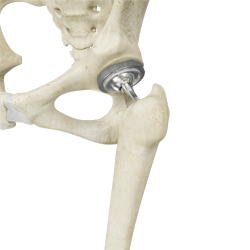
Total Hip Replacement Surgeon in Raleigh, Garner, Cary, NC.
Joint conditions such as arthritis may cause damage to the cartilage and bones leading to chronic pain in the hip and/or disability. The condition can be treated by replacing the damaged parts with artificial components. Dr. McNabb provides expert diagnosis and hip replacement surgery in Raleigh, Garner and Cary, NC. Contact Dr. McNabb’s office for an appointment today!

What is Total Hip Replacement?
Total hip replacement is a surgical procedure in which the damaged cartilage and bone are removed from the hip joint and replaced with artificial components. The main indication for total hip replacement is arthritis.
Arthritis is the inflammation of joints, which results in pain, swelling, stiffness and limited movement. Hip arthritis is a common cause of chronic hip pain and disability.
Symptoms of Arthritis
The most common symptom of hip arthritis is joint pain and stiffness, resulting in a limited range of motion. Vigorous activity can increase pain and stiffness, which may cause limping while walking.
Diagnosis of Arthritis
Diagnosis is made by evaluating your medical history, performing a physical examination and taking X-rays of the arthritic joint.
Total Hip Replacement Procedure
Surgery may be recommended if conservative treatment options such as anti-inflammatory medications and physical therapy do not relieve your symptoms.
Your doctor may ask you to start preparing 4 to 6 weeks before the surgery. The preparation might begin with blood tests, ECG and X-rays.
Subsequently, you are likely to be told to:
- Stop smoking (if applicable)
- Eat a healthy diet
- Maintain good physical condition
- Reduce your weight (if you are overweight)
- Perform exercises to strengthen hip muscles
- Not eat or drink anything after midnight on the day of the surgery
During the procedure, a surgical cut is made over the hip to expose the hip joint and the femur is dislocated from the acetabulum. The surface of the socket is cleaned and the damaged or arthritic bone removed using a reamer. The acetabular component is inserted into the socket. A liner made of plastic, is placed inside the acetabular component.
The femur or thighbone is then prepared by removing the arthritic bone using special instruments to exactly fit the new metal femoral component into the femur. The femoral component is then inserted to the femur either by a press fit or rarely using bone cement. Then the femoral head component made typically of ceramic is placed on the femoral stem. The muscles and tendons around the new joint are repaired and the incision is closed.
Postoperative Care following Total Hip Replacement
After undergoing total hip replacement, you must take special care to prevent the new joint from dislocating and ensure proper healing. Some of the common precautions to be taken include:
- Avoid the combined movement of bending your hip past 90 degrees
- Keep a pillow between your legs while sleeping for 6 weeks
- Do not cross your legs
- Avoid sitting on a low chair to avoid excessive flexion of your hip
- Avoid getting the foot of your operated leg too far behind you
Risks and Complications of Total Hip Replacement
As with any major surgical procedure, there are certain potential risks and complications involved with total hip replacement surgery. The possible complications after total hip replacement may include:
- Infection
- Dislocation
- Leg length inequality
- Injury to nerves or blood vessels
- Formation of blood clots in the leg veins or lungs
- Fracture of the femur or pelvis
- Wearing out of the hip prosthesis
- Failure to relieve pain
- Scar formation resulting in stiffness
If you would like to have additional information on the treatment of hip arthritis or would like to learn more about total hip replacement, please contact Dr. McNabb, serving the communities of Raleigh, Garner, Cary, NC.






